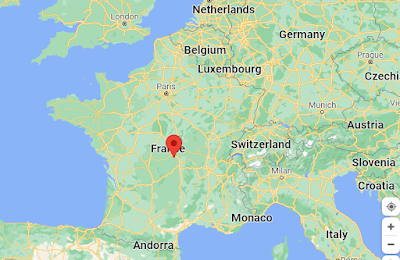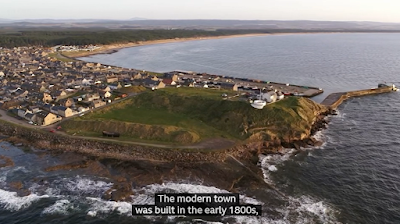A quiet day, even by mine and Lois's standards - my god! But it feels quite cold again, although by world standards it isn't that cold. Even central France is colder than here.
I recently posted on social media a picture of Lois and me outside the Gupshill Manor hotel/restaurant in nearby Tewkesbury, and our friend Annie, an Englishwoman who lives in the Auvergne, central France, admired our blue skies and commented that not only was the temperature much lower where she is, but also that she hadn't seen the sun for yonks.
flashback to Sunday: Lois and me outside the
Gupshill Manor hotel-restaurant - lovely blue skies !!!!!
central France, where our friend Annie lives - brrrrrr !!!!!!
flashback to 2007: our friend Annie, an Englishwoman who lives
in the Auvergne, Central France
2007: me sitting in Annie's garden
flashback to 2003: (left to right) Annie, Annie's English friend Doreen,
a goose (?) and Lois
2003 - we drive our car through the Auvergne's volcanic region
being careful to drive on the right hand side of the road:
My god we're so "conformist" haha!
What a crazy planet we live on !!!!
And did you notice Annie's use of the word "nesh" in her comments? [No - Ed] Lois knew this word, but I didn't - it's a dialect word and it means "unusually susceptible to cold weather". Who knew that? [Well, Lois and Annie did obviously! - Ed] And it was there in the language a thousand years ago - "hnesce" in Anglo-Saxon.
It's mainly used in Northern England but also regionally in Scotland, Newfoundland and parts of the US. What a crazy language we speak haha!!!!
09:00 It feels cold when Lois and I get out of bed, so I warm up with a bowl of porridge, which is fast becoming my go-to breakfast.
You're probably wondering how I prepare the porridge.
[No, I'm not! - Ed].
Well, at last I can reveal my personal recipe for the perfect bowl of porridge. It's 2 oz oats (60g), 9 fl oz (266 ml?) milk-and-water, heated in the microwave for 3 minutes, with half a teaspoon of Golden Syrup stirred in.
See? Simples !!!!!
Now I do feel slightly warmer.
10:00 We change the sheets on our bed, and put the chocolate-coloured sheets and duvet cover on, which always make us feel warmer, although Lois thinks it's just psychological.
11:00 Lois goes out into the back garden to photograph the frost on the lawn, and the effect of winter on our red cabbage in one of our raised beds.
Poor red cabbage !!!!! Brrrrr!!!!
Then, while I do List A of the exercises that Connor, my NHS physio, has scheduled for me today, Lois goes out for a walk round the local football field. There's hardly anybody around, she reports later, and all four benches are vacant.
Lois pauses in her walk to take an awkward selfie
all four benches are vacant today, including
the so-called "Pirie Bench", our runaway favourite because of
its unfashionably shallow depth, which means can you sit comfortable on it,
which is an important attribute for a bench we feel haha!
16:30 Lois is in the kitchen listening to the Inside Science programme on BBC Radio 4. They're still talking about the 33 foot long 200 million-year-old ichthyosaur fossil discovered a year or so ago in Rutland Water.

I hadn't realised that this fossil found in Rutland Water is the first complete ichthyosaur to have been found. They've come across incomplete ones before, especially in Germany, but this is the first whole one, found in situ where it died. The skull has now been removed, as we saw in yesterday's TV programme, and taken into the labs, where it should be possible to determine whether or not it's the same type of ichthyosaur as the German ones, or whether it's a different or even an unknown variety of creature.
Fascinating stuff !!!!
20:00 We watch some TV, the 6th and final part of Alice Roberts's series "Digging for Britain", which reviews the most significant archaeological remains found in the UK over the last 12 months. In this programme Alice returns to Scotland and the north of England.
Another interesting programme. I'm always fascinated to hear about the Picts, the mysterious and possibly ferocious people who lived in northern Scotland, out of the reach of, and beyond the capabilities of, the Romans when they started conquering Britain in 43AD.
A large fort was discovered at Burghead in north-eastern Scotland in the 1790's, a fort that is now believed to have been a major seat of power for the Picts. And we know that a Pictish kingdom dominated northern Scotland throughout most of the medieval period.
The green area where the fort was found can be seen on the promontory in the above pictures. It was a fort protected by 3 massive ramparts as well as being protected by the cliffs on the seaward side. The sophistication of the defences as well as some of last year's Aberdeen University team's finds, like pins, gold buttons and combs, and even a stylus for writing, suggest the Picts were not as "barbaric" as the Romans said they were.
Reconstruction: this is approximately what the fort would have
looked like during its peak period, in the 9th century
It's not known for certain what the Pictish language was like, because they had no script of their own, but mainly from place-name evidence it's generally believed to have been a Celtic language, like Brythonic, and related to Welsh, Breton and Cornish.
Pictish and Brythonic later disappeared from Scotland altogether, submerged by the Anglo-Saxon dialects of the southern Scots, and also by Irish (Goidelic - Gaelic) and by Norse, after waves of invasions from Ireland and Scandinavia.
Poor Picts !!!!!!
And who wouldn't want to meet a young woman from the mid-15th century? Well, I think I'm right in saying that that's not strictly possible at the moment given the limitations of current medical science. But at least you can see a picture of one, which is something!
The excavation of a huge medieval graveyard in Leith, has so far uncovered 85 skeletons, and the remains include those of a young woman with a large hole in the top of her skull.
excavations of a medieval cemetery in Leith near Edinburgh,
under ground earmarked for a new tramline
the woman with a huge hole in her skull, presumably hit with something -
but the wound didn't kill her: the rounded edge points to bone regrowth
There are also signs that the woman received medical care - doctors had gone in to remove bone and clean up the edges, enabling bone regrowth, something you wouldn't normally have guessed given that it was 600 years or so ago - my god!
The skull is in such good condition that researchers have been able to reconstruct what the young woman's face would have looked like before her injury.
programme presenter Alice Roberts discusses the
reconstruction with the dig's lead archaeologist, John Lawson
A useful reminder that even people from the 15th century were people just like us.
Fascinating stuff (again) !!!!
22:00 We go to bed - zzzzzzzz!!!!!
























No comments:
Post a Comment